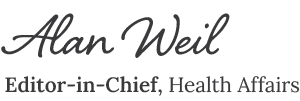Didem Bernard and colleagues examine the health-related financial burden on American families, using a comprehensive measure that includes out-of-pocket spending, medical debt, and cost-related care delays.
They determine that 27.0 percent of adults younger than age sixty-five live in families with at least one of these indicators of financial strain.
When they used a looser definition of financial strain, that share increased to 45.4 percent.
Gary Claxton and coauthors report findings from the twenty-fifth annual KFF Employer Health Benefits Survey.
The average annual premium for employer-sponsored family health insurance coverage was just shy of $24,000 in 2023, a 7 percent increase from 2022.
More than half of employers with fifty or more workers believe that their employees have a high or moderate level of concern about affording their health plan’s cost sharing.
In a DataWatch, Simon Haeder and colleagues show that merging rural and urban Affordable Care Act Marketplace rating areas in Texas significantly reduced rural premiums and improved the choice of carriers and plans for rural residents.
List prices of newly launched life-altering gene therapies can now reach into the millions of dollars.
In a Policy Insight, Caroline Horrow and Aaron Kesselheim present a taxonomy of possible payment approaches for these therapies, describing mechanisms that include risk pools, reinsurance, subscription models, outcomes-based agreements, and more.
In a Narrative Matters essay, Paula Steiner, a former health insurance plan executive, considers the role of profit in health insurance and health care.
Reflecting on her professional experiences, she concludes that “our national fixation on profits is a trap.” The real issue, she believes, is that “we have willingly limited who and what we pay for when facing the bills but rejected such thinking when confronting the illness.”




